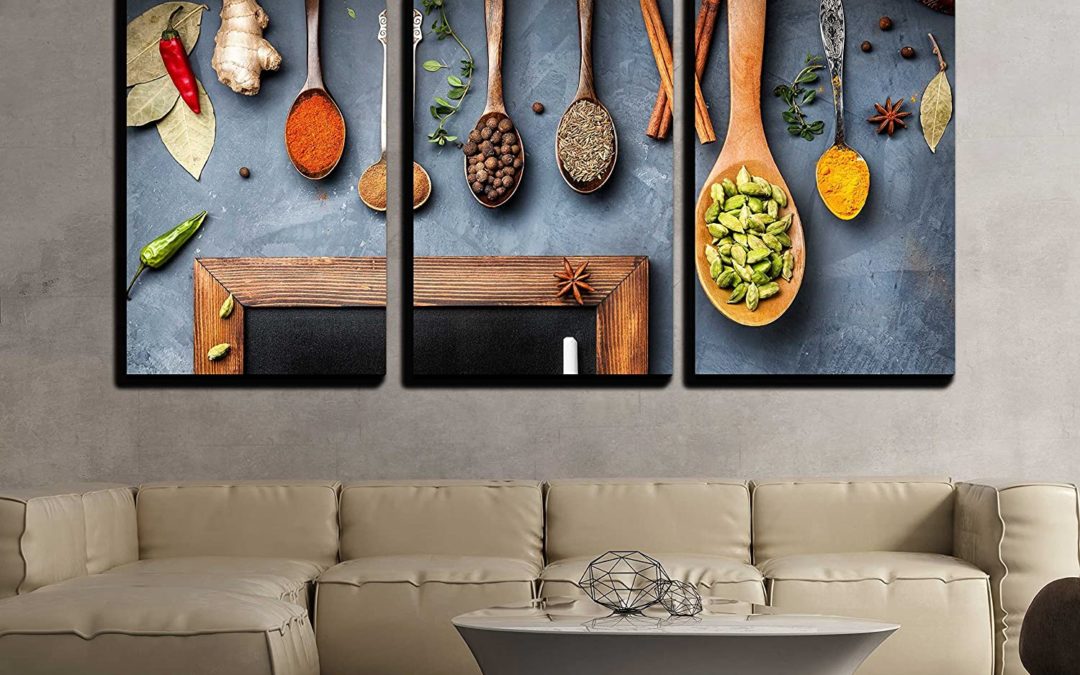Spices, herbs and blends of both are the best methods to enhance the natural flavors of any food product. With just a dash of a certain spice, one can elevate food to culinary perfection. That said, many people don’t know much about spices other than what they taste like. Many people know quite a bit about chickens or cows, but do you know much about the cultivation of saffron? The history of peppercorns? What about garlic? If you would like more insight on the role that herbs and spices play in our culinary lives, then read below for some spice wall art facts!
Peppercorns & Garlic
- Did you know that peppercorns have been used as a food seasoning for over 4,000 years? If you’re unfamiliar with peppercorns, you probably know them better as “black pepper”. The black pepper that you sprinkle into your dishes are simply crushed black peppercorns. Peppercorns come in a variety of colors; red, green, black and even white. Each peppercorn has a distinct flavor, and many are used in different cultural cuisines for a specific taste.
- Have you ever heard of black garlic? Black garlic is fermented garlic. Confused? Well, to better explain we can use meat as an example. You’re probably familiar with the aging process of steak? Essentially steak is cut, then rested in a temperature controlled space for an extended amount of time. Garlic is very similar! Black garlic is made by storing garlic in a warm, heat-controlled environment until the individual garlic bulbs have aged. When they age, the garlic turns black and develops a sticky texture. The taste becomes much more refined and sweet, especially compared to regular garlic. Read below for more spice wall art facts.
Saffron & Allspice
- Are you familiar with Saffron? It’s one of the most expensive spices in the world! One bowl of saffron could be the equivalent of around $400 US dollars! This bright red spice is so expensive because each individual piece of saffron has to be collected by hand. Saffron comes from the inside of a flower, with each flower containing only 3 to 5 pieces of saffron. Essentially, this means that you would need around 100 plants just for one gram of saffron! Saffron is very potent when heated, which means that only a few strands are necessary to infuse its flavor into your dish.
- Have you ever had jerk seasoning on a piece of meat. For instance, jerk chicken is one of the most popular dishes in the world. Jerk seasoning gets its distinctive, almost indescribable flavor from a seasoning called “allspice.” Did you know that allspice was brought to worldwide attention by Christopher Columbus, the first European to discover the Americas? Originally called “pimento,” allspice got its current name because its flavor manages to taste like a blend of cinnamon, nutmeg and cloves. Read below for more spice wall art facts.
Chili Peppers & Bay Leaves
- Do you like spicy foods? Did you know that chili peppers are ranked in terms of spiciness with something called “Scoville units”? This unit of measurement was created by a man named Wilbur Scoville, who used a panel of pepper tasters to determine how much water was required to neutralize the heat of a chili pepper. Have you ever heard of a Carolina Reaper chili pepper? They’re becoming very popular across the United States and are now being put into spice blends and sauces for people who love heat! Carolina Reapers rank around 2.2 million on the Scoville heat scale!
- Have you ever heard of bay leaves? They’re immensely popular spices that look like they belong on a tree rather than in a cooking pot! These leaves are so popular that they’ve somehow found their ways into a multitude of cultural cuisines that couldn’t be more different from each other! Did you know that Mexcian, Greek and Italian cuisine all use bay leaves for different purposes? California bay leaves and Turkish bay leaves are two types of leaves used across these different cultures; the Turkish leaf has a milder flavor, while the California variety tastes much more vegetal. Read below for more spice wall art facts.
Similarities & Differences
- Are you still confused about the difference between herbs and spices? Herbs come from the leaf of a plant, while spices come from the buds, roots, bark or seeds of a plant. Essentially, this means that one plant can produce several different flavors, depending on which part of it is cultivated. Fenugreek, a popular plant used widely in Indian cuisine, is an example of this. Its green leaves are dried and sold as herbs, while its golden seeds are sold whole or as powder!
- When cooking, people often used rubs and seasonings for meat. For example, you may be planning to grill a steak during a barbecue in the near future. You may be wondering what the difference is between a “rub” and a seasoning blend. The difference is the size of the spice particles used between each of these seasoning types. Rubs are coarse with bigger granules. These coarse granules prevent the seasonings from burning easily while being cooked. Seasonings are tiny particles that are more useful for meats that have a shorter cooking time with a flame that isn’t quite as intense! Did you enjoy these spice wall art facts?
Conclusion
How do you feel now that you know much more about seasonings and spices? Are you more inclined to use them in your cooking? Why not add a dash of white pepper to a stir fry? Why not infuse your meatloaf with some black garlic? Are you vegetarian or vegan? Seasoning vegetables is just as useful as seasoning meat! Throw some red pepper flakes on your broccolini for a great kick of spice! We hope you enjoyed reading these spice wall art facts!



